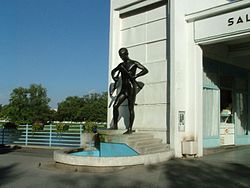Balneotherapy
| Balneotherapy | |
|---|---|
 | |
| MeSH | D001452 |
Balneotherapy (Template:Lang-la "bath") is the treatment of disease by bathing, usually practiced at spas.[1] While it is considered distinct from hydrotherapy,[2] there are some overlaps in practice and in underlying principles. Balneotherapy may involve hot or cold water, massage through moving water, relaxation, or stimulation. Many mineral waters at spas are rich in particular minerals such as silica, sulfur, selenium, and radium. Medicinal clays are also widely used, which practice is known as 'fangotherapy'.
Definition and characteristics

The term "balneotherapy" is generally applied to everything relating to spa treatment, including the drinking of waters and the use of hot baths and natural vapor baths, as well as of the various kinds of mud and sand used for hot applications. Balneotherapy refers to the medical use of these spas, as opposed to recreational use. Common minerals found in spa waters are sodium, magnesium, calcium, and iron, as well as arsenic, lithium, potassium, manganese, bromine, and iodine. All these may be contained in the peat that is commonly used in preparation of spa waters. Resorts may also add minerals or essential oils to naturally-occurring hot springs. Though balneotherapy commonly refers to mineral baths, the term may also apply to water treatments using regular hot or cold tap water.
Mud-baths are also included in balneotherapy, and the dirt and water used to mix mud baths may also contain minerals which are thought to have beneficial properties.
Treatment of diseases

Balneotherapy may be recommended for wide range of illnesses, including arthritis,[3] skin conditions and fibromyalgia.[4] As with any medical treatment, balneotherapy should be discussed with a physician before beginning treatment, since a number of conditions, like heart disease and pregnancy, can result in a serious adverse effect.
Scientific studies into the effectiveness of balneotherapy tend to be neutral or positive, finding that balneotherapy provides no effect or a placebo effect, or that there is a positive effect. However, many of these studies have methodological flaws, and so may not be entirely reliable.[5][needs update][6] A 2009 review of all published clinical evidence concluded that, while available data suggest that balneotherapy may be truly associated with improvement in several rheumatological diseases, existing research is not sufficiently strong to draw firm conclusions.[7]
See also
Notable spas
- Sapareva Banya 103 °C (217 °F), Bulgaria[8][9]
- Ananda – In the Himalayas, India
- Ein Bokek, near the Dead Sea, Israel
- Blue Lagoon (geothermal spa) in Iceland
- Băile Govora (Spa town) in Vâlcea County, Romania
- Druskininkai (Spa town) in Lithuania
- Karlovy Vary, Mariánské Lázně and Františkovy Lázně in the Czech Republic
- Piešťany in Slovakia
- Medical center Rogaška in Slovenia
- Termas de Río Hondo, en Santiago del Estero, Argentina
- Warm Springs, Georgia, USA
- Bath, England
See also
References
- ^ Angus Stevenson, ed. (2007). "Definition of balneo therapy". Shorter Oxford English Dictionary. Vol. 1: A-M (6th ed.). Oxford: Oxford University Press. p. 180. ISBN 978-0-19-920687-2.
- ^ "Balneotherapeutics". The Encyclopaedia Britannica (1911). Vol. III. New York. pp. 284–285 (300–301 in electronic page field). Retrieved 16 July 2011.
- ^ Sukenik S; Flusser, D; Codish, S; Abu-Shakra, M (1999). "Balneotherapy at the Dead Sea area for knee osteoarthritis". IMAJ. 1 (2): 83–85. PMID 10731301.
- ^ Deniz Evcik; Kizilay, B; Gökçen, E (June 2002). "The effects of balneotherapy on fibromyalgia patients". Rheumatology International. 22 (2): 56–59. doi:10.1007/s00296-002-0189-8. PMID 12070676.
- ^ Verhagen, AP; Bierma-Zeinstra, SM; Cardoso, JR; de Bie, RA; Boers, M; de Vet, HC (2003). "Balneotherapy for rheumatoid arthritis". The Cochrane database of systematic reviews (4): CD000518. doi:10.1002/14651858.CD000518. PMID 14583923.
- ^ Verhagen AP; De Vet, HC; De Bie, RA; Kessels, AG; Boers, M; Knipschild, PG (October 1997). "Taking baths: the efficacy of balneotherapy in patients with arthritis. A systematic review". J Rheumatol. 24 (10): 1964–71. PMID 9330940.
- ^ Falagas ME; et al. (2009). "The therapeutic effect of balneotherapy: Evaluation of the evidence from randomized controlled trials". International Journal of Clinical Practice. 63 (7): 1068–84. doi:10.1111/j.1742-1241.2009.02062.x. PMID 19570124.
- ^ Gergov, Spas (1974). Bulgaria. University of Michigan: Naouka i izkoustvo. p. 206.
- ^ Специализирана болница за рехабилитация „Сапарева баня" АД, гр. Сапарева баня
Further reading
- Nathaniel Altman, Healing springs: the ultimate guide to taking the waters : from hidden springs to the world's greatest spas. Inner Traditions / Bear & Company, 2000. ISBN 0-89281-836-0
- Dian Dincin Buchman, The complete book of water healing. 2nd ed., McGraw-Hill Professional, 2001. ISBN 0-658-01378-5
- Jane Crebbin-Bailey, John W. Harcup, John Harrington, The Spa Book: The Official Guide to Spa Therapy. Publisher: Cengage Learning EMEA, 2005. ISBN 1-86152-917-1
- Esti Dvorjetski, Leisure, pleasure, and healing: spa culture and medicine in ancient eastern Mediterranean., E. J. Brill, 2007 (illustrated). ISBN 90-04-15681-X
- Carola Koenig, Specialized Hydro-, Balneo-and Medicinal Bath Therapy. Publisher: iUniverse, 2005. ISBN 0-595-36508-6
- Anne Williams, Spa bodywork: a guide for massage therapists. Lippincott Williams & Wilkins, 2006. ISBN 0-7817-5578-6
